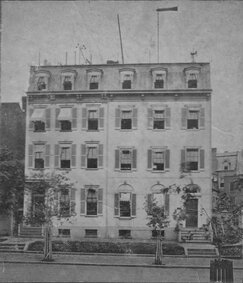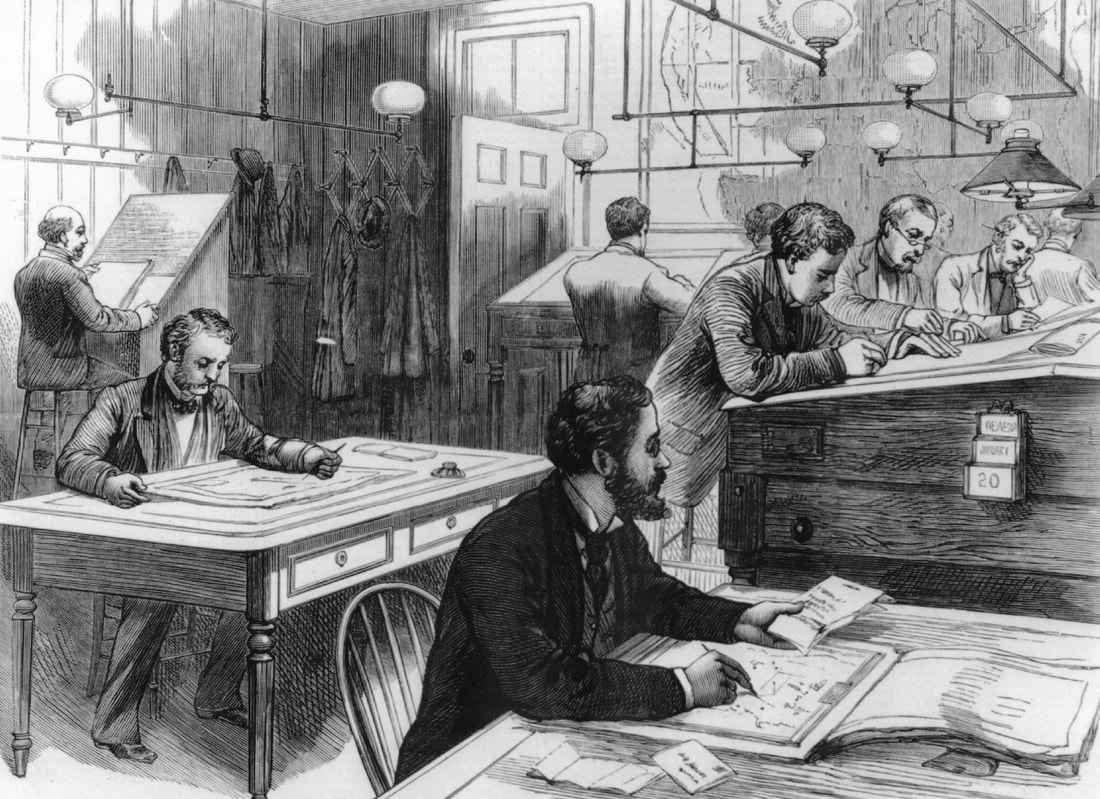Menu
The US Signal Service Years (1870-1891)
At the recommendation of Joseph Henry of the Smithsonian, on February 9, 1870 the US Congress authorized "the Secretary of War to take meteorological observations at the military stations in the interior of the continent, at other points in the states and territories of the United States, and to give notice on the Northern Lakes and Sea-coast, by magnetic telegraph and marine signals, of the approach and force of storms." In 1871, Congress extended this authorization to river stages and floods, and in 1872 this was further extended to predictions for the benefit of agriculture and commerce. Due to the involvement of telegraphy, this task was assigned to the US Army Signal Office, later referred to as the Signal Service and now the Signal Corps. Assignment of this responsibility to the army is at the root of the establishment of a government weather service in the US.
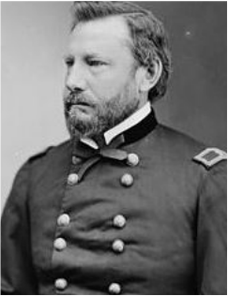 Albert J Myer
Albert J Myer
The Chief Signal Officer of the US Army at the time was Colonel Albert J Myer (1828-1880). The Signal Service was authorized in 1860 and created as an organization in 1863. Myer served with the Signal Service during the American Civil War. Fort Myer in Virginia is named after him. By 1872 there were 66 stations in the Signal Service observation system. The "method of simultaneous reports", in today's terms synoptic meteorology, was used. Three observations per day were reported. In 1873 Myer proposed the world-wide exchange of simultaneous weather observations at the International Meteorological Congress in Vienna, presaging the WMO. The proposal was adopted, and by 1874 the international exchange of observations became extensive. The completion of a dependable transatlantic telegraph cable in 1866 facilitated this. Beginning in 1875, a daily international bulletin was issued by the Signal Service, including data from most of Europe, China, Japan, Australia, Latin America, South Africa, and reports from ships returning from sea.
|
The photo shows the Signal Service weather headquarters building, on G Street in Washington DC. The weather service occupied it from November 1, 1870 to August 15, 1888. On November 4, 1870, the first weather bulletins were telegraphed out by the Signal Service, based on simultaneous weather observations from 24 stations. The first storm warning, on the Great Lakes, went out a week later.
|
From February 1871, an article from Scribner's Monthly Magazine, "Weather Telegrams and Storm Forecasts by the American Signal Service", describing the start of the Signal Service weather service may be downloaded below (21 pages):
| weather_telegrams_and_storm_forecasts_by_the_american_signal_service_-_part_1_-_scribners_monthly_-_1871.pdf | |
| File Size: | 2129 kb |
| File Type: | |
From March 1871, Part 2 of this same publication may be downloaded below (26 pages):
| weather_telegrams_and_storm_forecasts_by_the_american_signal_service_-_part_2_-_scribners_monthly_-_1871.pdf | |
| File Size: | 2590 kb |
| File Type: | |
An August 1871 article from Harper's Magazine, "The Telegraph and the Storm", by T B Maury describing the early history of the Signal Service weather service can be downloaded below (21 pages):
| the_telegraph_and_the_storm_-_t_b_maury_-_august_1871.pdf | |
| File Size: | 2454 kb |
| File Type: | |
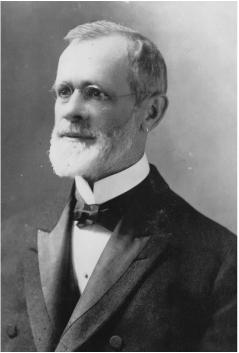 Cleveland Abbe
Cleveland Abbe
The data collection under the Signal Service was performed by military personnel, but the forecasting was performed by both civilians and military officers. The Chief Meteorologist in January 1871 was Cleveland Abbe (1838-1916), who previously performed forecasting duties at the Cincinnati Observatory. Abbe selected the instrumentation to be used and trained the military observers. At first he produced the weather maps, later he supervised their creation. In February 1871, Abbe sent out his first Signal Service forecast.
Abbe also founded the journal Monthly Weather Review in 1872. The US Weather Bureau continued its publication until 1970, and it is currently published by the American Meteorological Society. Abbe was also the force behind the adoption of standard time zones in the US, initially by railroads in 1883.
Cleveland Abbe's meteorological career continued well beyond the Signal Service years. He served as Chief Meteorologist in the US Weather Bureau, continuing to work there until his death in 1916. Many people consider him to be the father of the US National Weather Service.
Abbe also founded the journal Monthly Weather Review in 1872. The US Weather Bureau continued its publication until 1970, and it is currently published by the American Meteorological Society. Abbe was also the force behind the adoption of standard time zones in the US, initially by railroads in 1883.
Cleveland Abbe's meteorological career continued well beyond the Signal Service years. He served as Chief Meteorologist in the US Weather Bureau, continuing to work there until his death in 1916. Many people consider him to be the father of the US National Weather Service.
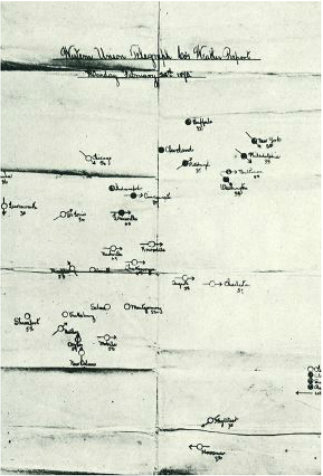 Abbe Weather Map from Cincinnati Observatory February 28, 1870
Abbe Weather Map from Cincinnati Observatory February 28, 1870
At first Signal Service forecasts were made for 24 hours ahead and included the state of the weather, wind, pressure, and temperature. Forecasts were made 3 times a day and applied to 8 to 11 districts which covered the United States. In 1885 this was changed to 32 hours ahead, and to 36 hours in 1888.
In 1874, the station instrumentation at Chicago (a major station) included "Two standard barometers, three standard thermometers, one standard minimum thermometer, one standard maximum thermometer, one standard water-thermometer, one standard hygrometer, one standard anemometer, one self-register for anemometer, one standard wind-vane, one standard rain-gauge." At Dodge City, Kansas (a lesser station) the instrumentation included "One standard barometer, one standard thermometer, one standard minimum thermometer, one standard maximum thermometer, one standard hygrometer, one standard anemometer, one small wind-vane, one standard rain gauge."
In 1874, at the insistence of Joseph Henry, the entire body of Smithsonian volunteer observers was transferred to the Signal Service. Their legacy continues today in the Cooperative Observer Program of the US National Weather Service.
In 1874, the station instrumentation at Chicago (a major station) included "Two standard barometers, three standard thermometers, one standard minimum thermometer, one standard maximum thermometer, one standard water-thermometer, one standard hygrometer, one standard anemometer, one self-register for anemometer, one standard wind-vane, one standard rain-gauge." At Dodge City, Kansas (a lesser station) the instrumentation included "One standard barometer, one standard thermometer, one standard minimum thermometer, one standard maximum thermometer, one standard hygrometer, one standard anemometer, one small wind-vane, one standard rain gauge."
In 1874, at the insistence of Joseph Henry, the entire body of Smithsonian volunteer observers was transferred to the Signal Service. Their legacy continues today in the Cooperative Observer Program of the US National Weather Service.
|
When Brigadier General Albert Myer died in 1880, General William B Hazen (1830-1887) became the Chief Signal Officer. Another Civil War veteran, Hazen extended the focus of the Signal Service weather bureau from data collection and forecasting to more basic scientific research. He was known mostly for his argumentative disposition. His term in office was marked by financial scandal and discord.
|
Upon Hazen's death in 1887, Major General Adolphus Greely (1844-1935) became Chief Signal Officer. Greely was a former polar explorer and is best known for a disastrous 1881-1883 expedition he led to the arctic where 19 of his 25-man crew died before a rescue expedition arrived. Greely attempted to calm the discord that arose under Hazen, but it was becoming clear that the army was not happy with running what was essentially a civilian service.
The 1887 manual 'General Instructions to Observers of the Signal Service", which is a manual for the military observing stations not the volunteer observers, can be downloaded below (147 pages):
| signal_service_-_instructions_to_observers_-_1887.pdf | |
| File Size: | 21641 kb |
| File Type: | |
An 1882 manual providing instructions to the voluntary observers is available below (112 pages):
| signal_sevice_-_instructions_to_voluntary_observers_-_1882.pdf | |
| File Size: | 60457 kb |
| File Type: | |
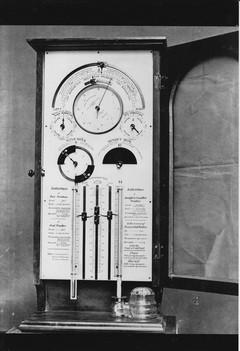 Signal Service Weather Station by L Casella ca 1880s
Signal Service Weather Station by L Casella ca 1880s
By 1890 the importance of weather predictions and climatic data in agriculture, commerce and daily life prompted a move to a weather bureau not associated with the military. On October 1, 1890 the US Congress approved the transfer of the weather bureau from the Signal Service to the US Department of Agriculture. The transfer became effective on July 1, 1891, ending the Signal Service weather bureau years. The US Army continued to train meteorological personnel for military service into the 20th century, but their domestic weather services had come to an end.
Annual reports of the Chief Signal Officer to the War Department for 1870 - 1891 can be downloaded here via Dropbox, courtesy the NOAA Central Library Data Imaging Project. I find the 1872 annual report particularly interesting for its first-hand report of the great Chicago Fire of October 1871, which destroyed the weather station and a large part of the city.
Go to next page.
Go to Home Page.
Annual reports of the Chief Signal Officer to the War Department for 1870 - 1891 can be downloaded here via Dropbox, courtesy the NOAA Central Library Data Imaging Project. I find the 1872 annual report particularly interesting for its first-hand report of the great Chicago Fire of October 1871, which destroyed the weather station and a large part of the city.
Go to next page.
Go to Home Page.
Proudly powered by Weebly
- - Home
-
- Instrument Collection
- - Microbarographs >
- - Thermographs >
- - Hygrographs >
- - Meteorographs >
- - Hygrothermographs >
-
- Barometers
>
-
- Aneroid Barometers
>
- + Airguide Barometer
- + Barigo 1500 Marine Barometer
- + Belfort 6079 Barometer
- + Bendix ML-102E Barometer
- + CENCO Barometer
- + Changchun DYM-3 Barometer
- + Fee & Stemwedel Marine Barometer
- + Fischer Type 103 Marine Barometer
- + Fischer Barometer #2
- + Friez N Aero 1936 USN Barometer
- + Friez Ship's Barometer
- + Friez Ships Barometer #2
- + Friez Ships Barometer #3
- + GMP Barometer
- + GMP MD-49-2 Barometer
- + GMS Barometer
- + James Pitkin Barometer
- + Kollsman Barometer
- + Lilley & Gillie Barometer
- + Lufft Altimeter Pressure Station
- + Lufft Marine Barometer
- + Mechanism Ltd M1991/A
- + Naudet Barometer
- + Naudet Marine Barometer
- + Negretti & Zambra M2236 Typ 2 Barometer
- + Observator Barometer
- + OTA Keiki Seisakusho Barometer
- + R Fuess Marine Barometer
- + R Fuess 1938 Barometer
- + Russian Barometer 1941
- + Safonovsky Gidrometpribor BAMM-1
- + Safonovsky Gidrometpribors M-67
- + SUNDO Barometer
- + Swift Scientist Barometer
- + Takahashi Barometer
- + Taylor Navy Barometer
- + Taylor Stormoguide Barometer
- + Taylor 2236 Commodore Barometer #3
- + Tycos 2252 Barometer
- + Tycos 2075FK Altimeter
- + Unknown Mining Altimeter
- + Utsuki Keiki Barometer
- + Wallace & Tiernan FA-139 Altimeter Setting Barometer
- + Wallace & Tiernan Fa-140 Barometer
- + Wallace & Tiernan ML-102-D
- + Welch 1233 Classroom Barometer
- + Wempe Marine Barometer
- + Yanagi 6 Marine Barometer
- + Yanagi 8A Marine Barometer
- - Mercury Barometers >
- - Tendency Barometers >
-
- Aneroid Barometers
>
-
- Thermometers
>
-
- Glass Bulb Thermometers
>
- + A J Dodge Thermometer
- + Henry J Green Thermometer
- + Hohmann & Maurer Thermometer
- + Palmer Marine Thermometer
- + Philadelphia Co Thermometer
- + Soil Thermometer
- + Soil Thermometer #2
- + Standard Thermometer
- + Taylor 5152(?) Thermometer
- + Taylor 17AA1 Thermometer
- + Tycos 5100 Thermometer
- + Taylor 5175 Classroom Thermometer
- + Unknown Marine Thermometer
- + US Army ML-7 Thermometer
- + Weksler USWB Pattern Thermometer
- + WM Welch 1259 Large ClassroomThermometer
- - Dial Thermometers >
- - Max Min Thermometers >
-
- Glass Bulb Thermometers
>
-
- Hygrometers
>
-
- Wet Bulb Hygrometers
>
- + Bendix Friez 566 Psychron
- + Fritz Lange-Optik Sling Psychrometer
- + ML-436 Assman Psychrometer
- + R Fuess Assmann Psychrometer
- + Taylor Pocket Sling Psychrometer
- - Tycos Lloyd's Hygrodeik
- + Tycos Mason's Hygrometer
- + Tycos Sling Psychrometer
- + Type MB-4 Aspiration Psychrometer
- + Weksler US Army Sling Psychrometer
- - Hair Hygrometers >
- - Membrane Hygrometer >
- - Coil Hygrometers >
-
- Wet Bulb Hygrometers
>
- - Anemometers >
-
- Pyranometers
>
- + Belfort 5-3850 Pyranograph
- + Casella Actinograph
- + Eppley Model 50 Pyrheliometer
- + Eppley Model 10 Pyrheliometer
- + Kipp & Zonen CM5 Pyranometer
- + Casella Campbell Stokes Temperate Sunshine Recorder
- + Casella Campbell Stokes Tropical Sunshine Recorder
- + Henry J Green Jordan Sunshine Recorder
- + R Fuess Black Bulb Thermometer
-
+ Rain and Evaporation
>
- + Visibility Meters >
-
+ Slide Rules
>
-
- Psychrometric Calculators
>
- + Bendix Friez Psychrometric Calculator
- + Casella T8563 Humidity Slide Rule
- + CP-165 Psychrometric Computer
- + CP-164 Psychrometric Computer
- + Feutron Type 1802 Slide Rule
- + Hunter Associates Psychrometric Calculator
- + Met Office Humidity Slide Rule
- + ML-322 Psychrometric Calculator
- + ML-429 Psychrometric Calculator
- + RSES Psychrometric Calculator
- + Weather Bureau Psychrometric Calculator
- - Pressure/Altitude Slide Rules >
- + Meteorological Slide Rules >
- - Wind Slide Rules >
- - Solar Slide Rule >
- - Data Reporting Slide Rules >
- - Weather Forecasting Slide Rules >
-
- Psychrometric Calculators
>
- + Other Instrument Collections
-
- Catalogs
- - Austria >
- - China >
- - France >
-
- Germany
>
- + A Kruss
- + Albert Zuckschwerdt
- + Alt Eberhardt und Jaeger
- + Amarell
- + Arnold Fliedner
- + Arthur J Foerster
- + Barigo
- + Binde und Wegener
- + Bogel und Letsch
- + Bohne
- + Carl Emil Rose
- + Carl Kellner
- + Carl Staschen
- + Carl Zeiss
- + Constantin Heintz
- + Enz Thermometer
- + Ephraim Greiner
- + F F Greiner
- + Fischer
- + Fritz Lange-Optik
- + Frobel
- + Gebr Bergmann
- + Georg Rosenmuller
- + Gischard
- + Glaswerke Ilmenau
- + Goerz AG
- + H C Kroplin
- + Hermann Kunzel
- + Hermann Schilling
- + Herra
- + Hilmar Bocks und Sohn
- + Hollein und Reinhardt
- + Hugo Schlegel
- + Hugo Wernicke
- + J&A Bosch
- + Junkalor
- + Kuchler und Sohne
- + Lambrecht
- + Lufft
- + Max Kohl AG
- + Moller Oemichen und Co
- + Paul Wegener
- + R Burger
- + R Fuess
- + R Treuer
- + Richard Muller
- + Roessel-Messtechnik
- + Scholz
- + Schreyer und Co
- + SUNDO/Stacker und Olms
- + Wolff-Rodenstock GmbH
- - Japan >
- - Netherlands >
- - Russia >
- - Switzerland >
- - United Kingdom >
-
- United States
>
- + Abbeon
- + A E Moeller
- + Airguide
- + A J Dodge/Charles Wilder
- + American Paulin
- + American Schaeffer and Budenberg
- + American Thermometer Co
- + B Kahn
- + Bacharach
- + Brooklyn Thermometer Co
- + Central Scientific Co (CENCO)
- + Chelsea Clock Company
- + Compass
- + Dietzgen
- + Eimer & Amend
- + Friez Bendix and Belfort
- + Gurley
- + Henry J Green
- + Honeywell
- + Jason
- + Kahlsico
- + Keuffel and Esser
- + M C Stewart
- + MAXIMUM Inc
- + McAllister
- + Oakton
- + Ohio Thermometer Company
- + Palmer
- + Phila Thermo Co
- + Queen and Company
- + Sargent
- + Science Associates
- + Selsi
- + Seth Thomas
- + Sierra Weather Instrument
- + Springfield
- + Standard Thermometer Co
- + Swift and Anderson
- + Taylor/Tycos
- + Tel-Tru
- + Verichron
- + W M Welch
- + Wallace and Tiernan
- + Weather Measure/Weathertronics
- + Weksler
- + Westclox
-
- Miscellaneous Downloads
- - US NWS History
- - Book Lists
- - Barometric Calculations
- + IMAPP
- - About Me
- - Contact Me
- - Analog Weather Blog
